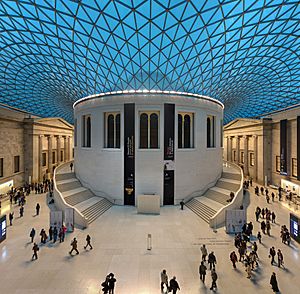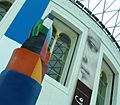Queen Elizabeth II Great Court facts for kids
The Queen Elizabeth II Great Court, often just called the Great Court, is a huge covered space at the heart of the British Museum in London. It's like a central courtyard that has a roof over it. This amazing area was redesigned in the late 1990s by a company called Foster and Partners. Queen Elizabeth II herself opened it in the year 2000.
Contents
What is the Great Court?
The Great Court has a special glass roof that looks like a puzzle made of many shapes. This roof was designed by engineers from Buro Happold and built by Waagner-Biro. It covers the entire court, surrounding the old, round British Museum Reading Room in the middle. This Reading Room is now part of the museum. The Great Court is the biggest covered square in all of Europe!
The Amazing Glass Roof
The roof is made of glass and steel. It has 4,878 unique steel pieces and 1,566 unique connection points. There are also 1,656 pairs of glass windowpanes, covering a huge area of 6,100 square meters. Each piece of glass is a different shape because the roof isn't flat; it gently curves and waves.
Some of the stone used in the court came from France. This was a bit of a surprise because the original plan was to use Portland Stone from southern England.
What Can You Find Inside?
Inside the Great Court, you'll find shops where you can buy souvenirs and a cozy café. The court acts like a main hub, connecting different parts of the museum. It's a bit like the famous Louvre Pyramid in Paris, which also serves as a central entrance for a museum.
How the Great Court Was Built
For a long time, the central courtyard of the British Museum was home to the British Library. This library had huge bookshelves, three stories high, filling the entire space. These were called the 'Book stacks'. If visitors wanted to get from one side of the museum to the other, they had to walk all the way around the outside.
Clearing the Way
In 1997, the British Library moved to a new building. Once it was gone, all those book stacks were removed. This cleared the way for the Great Court to be built in this newly empty central area. A new main floor was created, which is one story higher than the original courtyard. The space underneath this new floor is now used for the Clore Education Centre and the African galleries.
Important Changes
The South Portico, which is a grand entrance, was mostly rebuilt. Two new lifts were added there to help people with disabilities reach the upper levels of the museum easily.
The new glass roof, designed and built by Austrian experts Waagner-Biro, was placed over the entire courtyard. This created the large, covered space we see today at the heart of the museum.
The British Library Reading Room, which is the round building in the center, was kept and updated. It's now used as the Museum's own library and information center. Since the Reading Room didn't have an outer wall before (the bookshelves were right up against it), a new wall was built. This new wall protects the Reading Room, helps support the new roof, and hides the pipes that bring fresh air to the spaces below.
North of the Reading Room, there's a building with a museum shop on the ground floor. Above that, there's a gallery for special temporary exhibitions, and even higher up, just under the glass roof, there's a restaurant.
Learning and Education
The Clore Education Centre is located on the lower level of the Great Court. It has several important rooms for learning:
- The BP Lecture Theatre
- The Hugh and Catherine Stevenson Theatre
- The Raymond and Beverly Sackler seminar room
- A Studio, used for art and craft activities
- The Claus Moser seminar room
- The Ford Centre for Young Visitors
- The Samsung Digital Discovery Centre
A very important person, Nelson Mandela, spoke at the opening of the BP Lecture Theatre on November 16, 2000. He talked about how important the Museum's role is around the world.
Amazing Sculptures
When the Great Court first opened in 2000, twelve incredible sculptures from the British Museum's collection were placed on the main floor for everyone to see:
- A stone slab, called a stela, from the Assyrian King Ashurnasirpal II (about 9th century BC)
- A marble Lion of Knidos from Asia Minor (about 3rd century BC)
- Two heads of the Pharaoh Amenhotep III (around 1400 BC)
- Two tall, pointed stones called obelisks from the Egyptian King Nectanebo II (around 350 BC)
- Hoa Hakananai'a, a famous statue from Easter Island (its exact age is unknown, but it's from between 1200 and 1800 AD). This statue was later moved to Room 24.
- Two totem poles from British Columbia (19th Century AD)
- A Roman statue of a person on horseback (2nd century AD)
- An Irish memorial stone carved with Ogham script (5th century AD)
- An Anglo-Saxon cross shaft (late 8th or early 9th century AD)
- A pair of Chinese guardian figures (17th century AD)
- A column base from Persepolis (5th Century BC)
There were also plans to add a new, thirteenth sculpture by an artist named Anish Kapoor, but these plans were later cancelled.






